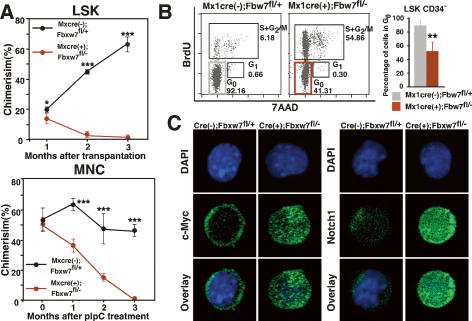Figure 2.
Reconstitution capacity and quiescence are impaired in Fbxw7-deficient HSCs. (A) Competitive repopulation analysis. (Left) Recipient Ly5.1 mice (n = 6) were transplanted with 1500 Fbxw7-deficient or control LSK cells together with 4 × 105 Ly5.1 × Ly5.2 competitor BM MNCs. Donor-derived chimerism of peripheral white blood cells was analyzed monthly after transplantation. (Right) Recipient Ly5.1 mice (n = 10) were transplanted with 4 × 105 BM MNCs from Mx-1-Cre(+);Fbxw7fl/− mice before pIpC treatment or with controls together with the same number of Ly5.1 × Ly5.2 competitor BM MNCs. pIpC treatment of recipient mice was performed 2 mo after transplantation. Donor-derived chimerism of peripheral white blood cells was then analyzed monthly after pIpC treatment. Results are shown as means ± SD. (B) Cell cycle status of LSK CD34− cells of Fbxw7-deficient or control mice. BrdU was administered for 3 d to mark cells that entered S phase, and 7-amino-actinomycin D (7-AAD) was administered to detect DNA content. Data shown are representative FACS patterns derived from three independent experiments (left) and graphs showing the mean percentage of cells in G0 (right). (C) LSK cells isolated from Fbxw7-deficient or control mice were stained with DAPI (blue) and anti-c-Myc antibody or anti-Notch1 antibody (green).

